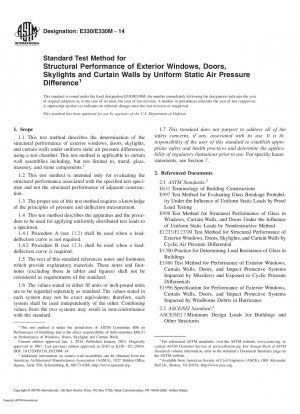ASTM E330/E330M-14
Standard Test Method for Structural Performance of Exterior Windows, Doors, Skylights and Curtain Walls by Uniform Static Air Pressure Difference
- Standard No.
- ASTM E330/E330M-14
- Release Date
- 2014
- Published By
- American Society for Testing and Materials (ASTM)
- Status
- Replace By
- ASTM E330/E330M-14(2021)
- Latest
- ASTM E330/E330M-14(2021)
- Scope
5.1 This test method is a standard procedure for determining structural performance under uniform static air pressure difference. This typically is intended to represent the effects of a wind load on exterior building surface elements. The actual loading on building surfaces is quite complex, varying with wind direction, time, height above ground, building shape, terrain, surrounding structures, and other factors. The resistance of many windows, curtain walls, and door assemblies to wind loading is also complex and depends on the complete history of load, magnitude, duration, and repetition. These factors are discussed in ASCE/SEI8201;7 and in the literature (1-8).5
5.2 Design wind velocities are selected for particular geographic locations and probabilities of occurrence based on data from wind velocity maps such as are provided in ASCE/SEI8201;7. These wind velocities are translated into uniform static air pressure differences and durations acting inward and outward. Complexities of wind pressures, as related to building design, wind intensity versus duration, frequency of occurrence, and other factors must be considered. Superimposed on sustained winds are gusting winds which, for short periods of time from a fraction of a second to a few seconds, are capable of moving at considerably higher velocities than the sustained winds. The analytical procedures in ASCE/SEI8201;7, wind tunnel studies, computer simulations, and model analyses are helpful in determining the appropriate design wind loads on exterior surface elements of buildings. Generally, wind load durations obtained from ASCE/SEI 7 are 2 to 10 s and are dependent upon the specific time reference employed in determining the pressure coefficients.
5.3 Some materials have strength or deflection characteristics that are time dependent. Therefore, the duration of the applied test load may have a significant impact on the performance of materials used in the test specimen. The most common examples of materials with time-dependent response characteristics that are used are glass, plastics, and composites that employ plastics. For this reason, the strength of an assembly is tested for the actual time duration to which it would be exposed to a sustained or a gust load, or both, as discussed above. Generally, U.S. practice for wind load testing has been to require a minimum test period of 10 s for test loads equal to the design wind load and proof loads equal to 1.5 times the design wind load. Thus a safety factor is incorporated in the testing. If the design wind load is determined through the analytical procedures of ASCE/SEI 7, the test load shall be based on the nominal loads derived from the load combinations used in allowable stress design. With test loads for wind higher than those determined by ASCE/SEI8201;7 or of longer time duration than 10 s, the designer must consider what safety factors are appropriate. For test loads that represent design loads other than wind, such as snow load, consideration shall be given to establish an appropriate test period for both design and proof load testing.
5.4 This standard is not intended to account for the effect of windborne debris or cyclic loads. Consideration of cyclic air pressure differentials is addressed in Test Method E1233/E1233M. Consideration of windborne debris in combination with cyclic air pressure differential representing extreme wind events is addressed in Test Method E1886 and Specification E1996.
5.5 This test method is not intended for use in evaluating the structural adequacy of glass for a pa......
ASTM E330/E330M-14 Referenced Document
- ASTM E1233/E1233M Standard Test Method for Structural Performance of Exterior Windows, Doors, Skylights, and Curtain Walls by Cyclic Air Pressure Differential*, 2024-04-20 Update
- ASTM E1300 Standard Practice for Determining Load Resistance of Glass in Buildings
- ASTM E1886 Standard Test Method for Performance of Exterior Windows, Curtain Walls, Doors, and Storm Shutters Impacted by Missile(s) and Exposed to Cyclic Pressure Differentials
- ASTM E1996 Standard Specification for Performance of Exterior Windows, Curtain Walls, Doors, and Impact Protective Systems Impacted by Windborne Debris in Hurricanes
- ASTM E631 Standard Terminology of Building Constructions
- ASTM E997 Standard Test Method for Structural Performance of Glass in Exterior Windows, Curtain Walls, and Doors Under the Influence of Uniform Static Loads by Destructive Methods
- ASTM E998 Standard Test Method for Structural Performance of Glass in Windows, Curtain Walls, and Doors Under the Influence of Uniform Static Loads by Nondestructive Method
ASTM E330/E330M-14 history
- 2021 ASTM E330/E330M-14(2021) Standard Test Method for Structural Performance of Exterior Windows, Doors, Skylights and Curtain Walls by Uniform Static Air Pressure Difference
- 2014 ASTM E330/E330M-14 Standard Test Method for Structural Performance of Exterior Windows, Doors, Skylights and Curtain Walls by Uniform Static Air Pressure Difference
- 2002 ASTM E330-02(2010) Standard Test Method for Structural Performance of Exterior Windows, Doors, Skylights and Curtain Walls by Uniform Static Air Pressure Difference
- 2002 ASTM E330-02 Standard Test Method for Structural Performance of Exterior Windows, Doors, Skylights and Curtain Walls by Uniform Static Air Pressure Difference
- 1997 ASTM E330-97e1 Standard Test Method for Structural Performance of Exterior Windows, Curtain Walls, and Doors by Uniform Static Air Pressure Difference
- 1990 ASTM E330-90 Standard Test Method for Structural Performance of Exterior Windows, Curtain Walls, and Doors by Uniform Static Air Pressure Difference
- 1979 ASTM E330-79 Standard Test Method for Structural Performance Of Exterior Windows, Curtain Walls, And Doors By Uniform Static Air Pressure Difference

Copyright ©2024 All Rights Reserved